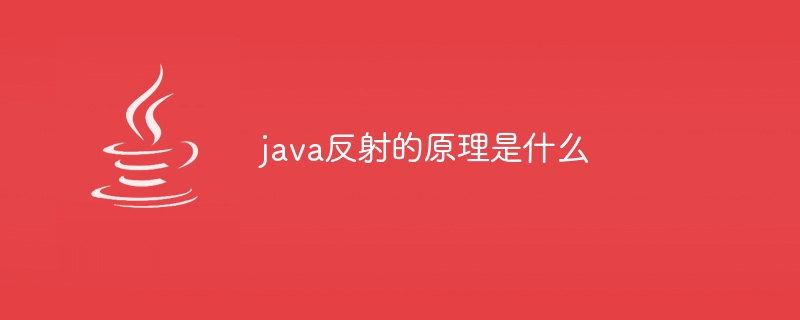Home >Java >javaTutorial >What is the principle of java reflection
What is the principle of java reflection
- 百草Original
- 2023-12-22 16:12:08973browse
The principle of Java reflection is that the Java runtime environment dynamically loads a class and obtains its detailed information, so that the properties and methods of the class or object can be manipulated. This mechanism allows objects to be dynamically created and called at runtime. Its properties or methods do not need to know in advance at compile time who the running object is. The reflection mechanism is implemented by loading ".class" files in the JVM, and then decompiling the corresponding Java code through these files to obtain detailed information about the class. This process is performed dynamically when the program is running, and dynamic loading and manipulation of classes can be achieved.

The operating system for this tutorial: Windows 10 system, DELL G3 computer.
The principle of Java reflection is that the Java runtime environment dynamically loads a class and obtains its detailed information, so that the properties and methods of the class or object can be manipulated. This mechanism allows you to dynamically create objects and call their properties or methods at runtime without knowing in advance who the running object is at compile time.
In Java, each object has a Class object. This Class object contains all information about the object, including its properties and methods. At runtime, through the reflection mechanism, the Java Virtual Machine (JVM) can obtain all information about the object through this Class object, and can dynamically create objects, call methods, get and set properties, etc.
Specifically, the reflection mechanism is implemented by loading .class files in the JVM, and then decompiling the corresponding Java code through these .class files to obtain detailed information about the class. This process is performed dynamically while the program is running, so dynamic loading and manipulation of classes can be achieved.
The Java reflection mechanism is a mechanism for obtaining and manipulating information such as classes, interfaces, fields, and methods at runtime. It has some advantages and disadvantages, which are introduced below:
Advantages:
1. Dynamic: The reflection mechanism can dynamically load and operate classes at runtime. Make the program more flexible and scalable.
2. Convenience: The reflection mechanism can easily obtain and operate the attributes, methods and constructors of the class, making the program easier to maintain and modify.
3. Versatility: The reflection mechanism can be used to process any type of object, including custom objects and objects from third-party libraries, making the program more versatile.
Disadvantages:
1. Performance issues: The reflection mechanism involves the analysis of dynamic types, so its execution efficiency is much lower than normal operation.
2. Security issues: The use of reflection technology usually requires running in an environment without security restrictions. If the program has security restrictions, reflection cannot be used.
3. Destruction of encapsulation: Reflection can access private properties and methods of a class, which may destroy the encapsulation of the class and lead to security holes or unpredictable behavior in the program.
4. Poor code readability: Reflective code is usually more complex and difficult to understand than ordinary code because it involves dynamically loading and operating classes.
In short, reflection is an important mechanism in Java, which allows programs to dynamically load and operate classes at runtime, thereby achieving a more flexible and scalable programming method. However, you need to pay attention to its shortcomings and limitations when using reflection to avoid overuse or incorrect use of reflection, which may lead to program performance degradation or security issues.
The above is the detailed content of What is the principle of java reflection. For more information, please follow other related articles on the PHP Chinese website!

